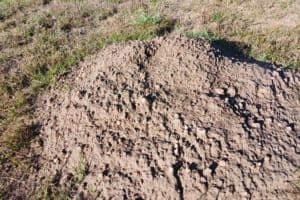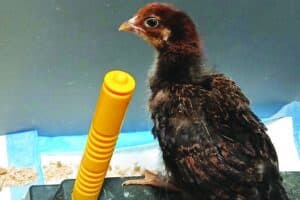Bill’s intro
Tiny toads abound
By Bill Radford
My history with amphibians in the Falcon area goes back to the years before I began living on the prairie, to a time when Falcon seemed like a faraway land from Colorado Springs.
In visiting Margaret’s sister, who lived in the area for a few years, we would pass a vernal pool at U.S. 24 and Garrett Road. It has long since been paved over, but back then it was home to tadpoles — a few of which we took home at one point and set up in an aquarium for our kids. After a rather stinky stay in the aquarium, the tadpoles grew up to become spadefoot toads and were moved to a terrarium.
The Colorado Parks & Wildlife website tells the unusual life history of the couch’s spadefoot: “Spends most of its life in the soil. Emerges to breed after heavy rains in spring or summer. Larvae develop quickly and metamorphose into small toads within a few weeks.”
Because of “that life in the soil,” our tiny toads would bury themselves in the dirt in their terrarium, and our kids would dig them up regularly to feed them crickets. Eventually, we returned the toads to their nature habitat where they could live the regular toad life.
Since moving to the prairie, we have seen a few spadefoots emerge from the pasture during wet summers. This summer, we have seen hordes of tiny toads; they don’t seem to be spadefoots, however, as they lack the stink and big feet for digging that we’re accustomed to in spadefoots.
We’re not the only ones who have noticed. A couple of neighbor girls brought over a glass bowl with a dozen tiny toads just to show them off before returning them to their lawn. And when I asked on Nextdoor, the online community hub, whether others were seeing an onslaught of the tiny toads, the answer was a resounding “Yes!”
“We have tons of them,” one neighbor posted. “They sure are cute,” another proclaimed.
But what are they?
At our house, we regularly see full-size toads each summer that we believed to be Woodhouse’s toads. We based that belief on the stripe that runs along the middle of the back of the toads, a distinguishing feature of the Woodhouse’s toad. Its breeding call, according to Parks & Wildlife: a loud “waaaaah” lasting about one-to-four seconds and emitted up to several times per minute.
We thought there was a possibility the toads might be great plains toads, as they also can have a stripe down their back. Their breeding call, Parks & Wildlife says, is “a long, continuous trill or pulsating ringing (at close range, similar to the ear-splitting sound of a jackhammer) lasting at least several seconds.” I would think that’s a sound we wouldn’t miss if we truly had great plains toads.
I turned to a definitive source for the answer: the Colorado Herpetological Society. I emailed photos of the big and tiny toads to the group via Facebook; it confirmed they were adult and baby Woodhouse’s toads.
It’s impossible to say how many of the babies are out there. A female Woodhouse’s toad can lay up to 25,000 eggs, various online sources state. If this were a horror movie, you could call it “Terror of the Tiny Toads.” But the only scary thing about them is the fear of stepping on them or shredding them when mowing the lawn.
Some folks on Nextdoor warn against letting your dogs “play” with the toads. The ASPCA notes that, “As you can imagine, toads don’t like to be eaten, licked or chewed, so they have a unique defense mechanism — they secrete fluids from their glands to ward off predators.” The signs of your dog having a close encounter with a toad include “excessive drooling, foaming at the mouth and pawing at the mouth.”
Our Boston terrier Gremlin has had several such encounters and returned from the backyard foaming at the mouth; you would think at some point he would figure out it is unwise to lick a toad. The good news, according to the ASPCA, is that most toads are only mildly toxic. One exception: the Colorado River toad, which despite its name is found only in Arizona, New Mexico and California, the ASPCA states.
Toad-licking dogs aside, we’re happy to have the toads hang out and eat all the insects they can. Which is a lot: Various sources state an adult toad can eat up to 1,000 insects a day. Our toads don’t seem to have had an impact on the typical summer crush of grasshoppers, though. But then a lot of the grasshoppers are bigger than the baby toads.
Want to learn more? Search online for Colorado Parks & Wildlife’s “Quick Key to Amphibians and Reptiles of Colorado.”
It’s impossible to say how many of the babies (toads) are out there. A female Woodhouse’s toad can lay up to 25,000 eggs, various online sources state. If this were a horror movie, you could call it “Terror of the Tiny Toads.” But the only scary thing about them is the fear of stepping on them or shredding them when mowing the lawn.
Photos by Bill Radford

A baby Woodhouse’s toad: Those are pebbles, not boulders, that the toad is resting on.





